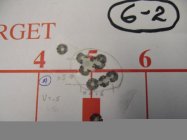HuskerP7M8 said:
Ron, It sometimes helps to form a composite group of all the individual shots in a testing session because this often allows you to more easily identify the “true” accuracy of a firearm and determine if perceived flyers are real or just part of the normal pattern all firearms exhibit with a large number of shots.
The first image below shows the 9 3-shot groups you fired as if all 27 shots were fired on one target. The only alteration I made in plotting these 27 shots, was to move the first 9 shots 0.25” to the left because you stated there might have been a windage adjustment to your scope after they were fired. The mathematical center of the first 9 was approximately 0.25” to the right of the mathematical center of the last 18, so I’m guessing that was indeed the case.
The second image shows the exact same group, but I shrunk the P’sOI so you can easily distinguish each individual shot. The 9 points colored red are the altered shots from your first target. Landy
Landy first thanks for the analysis of the target. And hello again. I think it has been over two years since we were discussing the merits of the TTEST in analyzing two shot groups of .22LR ammo. As you can see I've moved from good sound statistical analysis to using less shots and the seat of my pants instead of the TTEST!
I think I get the point you are trying to make. The outliers are contained within a reasonable pattern, so potentially they are not flyers, but just expected edges within a normal distribution. That said, your second graph, with a couple of red exceptions does seem to show a high group and a low group, or potential double grouping as was suggested earlier in the thread.
I had noticed that as well even without the excellent graphical display. One thing I am doing that I probably did not explain fully is sort bullets by body diameter, and also cases by weight. On the loading bench I number them and pre-sort them into the groups I will shoot. I don't sort to the extent where all bullets and cases are the same for a complete three group target, but they are all the same for one group. So if this sorting does have any value, it would tend to minimize variation within a group, but not from group to group. I've also got to check my records again, but at some of these targets were shot with virgin brass, while some may have been shot with 4X fired brass. Again, not within one group, but possibly from group to group.
In any case, thanks again for the analysis. Certainly gives me something to think about.














